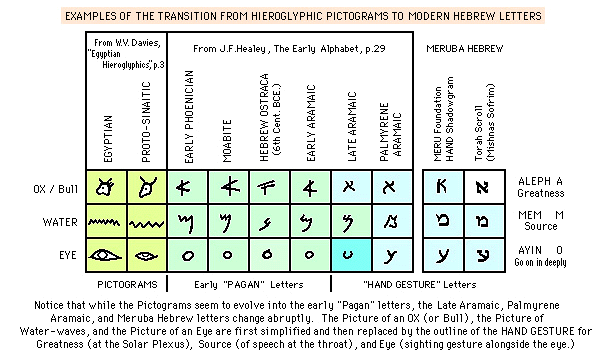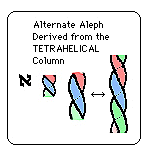Originally published in the Meru Foundation Journal,
TORUS, Vol. 2 #4, January 1994
©1994 Stan Tenen
This Appendix was originally published as one of a series of articles in TORUS, Vol. 2 #4, which included the Index to Letter-Meanings available elsewhere on this website.
OCCAM'S RAZOR is the principle in science that teaches that given more than one theory or solution to a problem the simpler and more elegant formulation is the correct one. There is no need to choose a complex theory when a simple one gives the same results. It is assumed that Mother Nature does not act gratuitously. This principle helps us when we need to find a universal solution to a problem. The simplest solution is, by definition the single - that is, the one uniquely most simple - solution. There is only one simplest. While many other solutions may be valid and even useful in particular cultures or circumstances, when we desire to solve a problem in a way that we have a right to expect another independent researcher to also arrive at, we and the other researcher must both seek the single most simple representation. Occam's Razor is thus an extremely useful tool for scientific modeling and in communication between parties that have not met previously.
THE TOROIDAL 7-COLOR MAP: One question
that arises when we propose the use of a torus defined by a 7-color 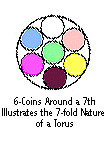 map
for understanding ancient alphabets concerns knowledge of the 7-fold nature
of the torus-surface in the ancient world. It is not likely that they were
aware of modern mathematical formalisms. Did they know about the 7-color
map, and if so, how did they know this?
map
for understanding ancient alphabets concerns knowledge of the 7-fold nature
of the torus-surface in the ancient world. It is not likely that they were
aware of modern mathematical formalisms. Did they know about the 7-color
map, and if so, how did they know this? 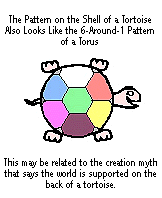
The answer is fairly simple. A torus is sometimes described as "a wheel of wheels"; it is a circle taken around a circle. When we attempt to draw a torus on a flat page, we draw a circle and then we draw a smaller circle inside to represent the hole. Anyone who has played with coins likely has noticed that it is always possible to place exactly 6-coins around a 7th in the center (when the coins are all the same diameter). A combination of these two models is illustrated above. We can tell that this is a drawing of a torus and not a drawing of a flat ring or washer because we can see the circular cross-section of the torus represented by the 6-coins (or wheels or circles) surrounding the center coin which represents the hole. This is not a mathematical proof, but it is a demonstration of how experience with simple available materials can provide the insight that a torus has a 7-fold property.
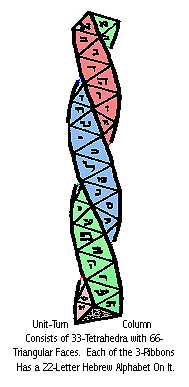
Letter skip patterns have been found in the Torah by Prof. Daniel Michaelson and other independent researchers at UCLA and Hebrew University. The predominant skip is either 49 or 50-letters. This is exactly the length in Teterahedra of 1-model Hand (without and with a 50th Tetrahedron at the tip of the "thumb"). If the Torah text is written on the 3,10 Torus Knot, letters separated by 49 and 50 letters will line up in concentric circles.
THE TETRAHELICAL COLUMN with a one-turn twist can represent the human spinal column. The spinal column has 33-vertebrae and the Tetrahelical column has 33-Tetrahedra. Because two triangular faces are displayed for each tetrahedron on the sides of the column, a 33-Tetrahedron column displays 66-total triangular faces. These are distributed as 3-ribbons of 22-letters on each of the 3-sides of the column.
"A quantum system is represented by a vector (called the state vector) which rotates in an abstract space.. It is just like a clock hand except that a clock hand is rotating in 2-d space, whereas the quantum state vector might be rotating in a hyperspace."
W.V. Davies, Egyptian Hieroglyphs, 1987,
(p.60, Table 3), and John F. Healey, The Early Alphabet,
1990, (p.29), are both part of the Reading the Past series, University
of California Press, Berkeley.
|
|
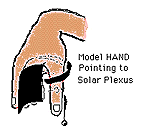 The Aleph from the HAND shadowgram, shown in the chart above, is generated as the Solar Plexus gesture and it matches samples of the rabbinic script form of Meruba used in Islamic Spain. |
"THE LIGHT IN THE MEETING TENT"
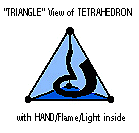 The
modern Babylonian (Assyrian - "Ashurit") style Hebrew letters are called
Meruba
The
modern Babylonian (Assyrian - "Ashurit") style Hebrew letters are called
Meruba![]() -
"square-shaped" or "four-fold" from the root ar-ba
-
"square-shaped" or "four-fold" from the root ar-ba![]() meaning
"four" and the prefix M
meaning
"four" and the prefix M![]() meaning "from." It is generally assumed that this refers to the squarish
shape of the Babylonian-style letters. However, rabbinic handwriting in
Islamic Spain is fluid and curved and not really square-shaped as is the
stylized form of the letters intended for sacred writing and Torah scrolls
(described in draftsmen's detail in Mishnas Sofrim - the rabbinic
instructions for scribes.)
meaning "from." It is generally assumed that this refers to the squarish
shape of the Babylonian-style letters. However, rabbinic handwriting in
Islamic Spain is fluid and curved and not really square-shaped as is the
stylized form of the letters intended for sacred writing and Torah scrolls
(described in draftsmen's detail in Mishnas Sofrim - the rabbinic
instructions for scribes.)
There is an alternate explanation for the designation of "4-fold": The
model Hand is formed in a tetrahedral frame. The Tetrahedron is the logical,
structural, complement of the Torus from which the vortex shaped Hand is
derived. The 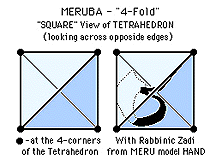 Tetrahedron
is entirely symmetrical; the vortex-Hand is entirely asymmetrical. Together
they form a model of Unity. (The "Light in the Tent of Meeting"
or "A Flame Wedded to a Coal", as the Kabbalists put it. - The flame
or light is the model Hand.)
Tetrahedron
is entirely symmetrical; the vortex-Hand is entirely asymmetrical. Together
they form a model of Unity. (The "Light in the Tent of Meeting"
or "A Flame Wedded to a Coal", as the Kabbalists put it. - The flame
or light is the model Hand.)
While a Tetrahedron looks like a triangular pyramid (all 4-faces, including
the base, are perfect triangles) in 3-dimensions, when it is projected
onto a 2-dimensional page it an look exactly like a square. 2-dimensional
shadows of the 3-dimensional Hand/flame/light inside form the letters.
Back to Meru Foundation Home Page
Contents of this page are ©1994, 1996 Stan Tenen,
and licensed to Meru Foundation, 524 San Anselmo Ave. #214, San Anselmo, CA 94960.
Email inquiries to: meru@meru.org

